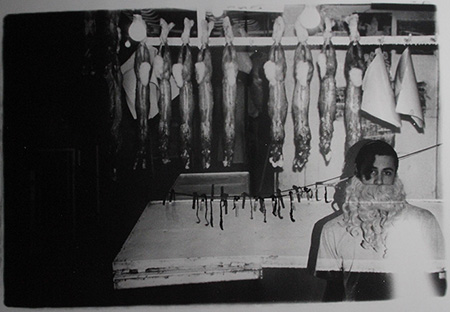
Continuing through December 23, 2023
Tim Roda was born and currently lives on the East Coast. But the Italian American artist got his professional start in Seattle after attending the Graduate School of Art at the University of Washington in ceramics. Roda returns for his fourth solo show since his 2003 debut, having built a formidable international presence in the twenty years since. His constructed-set black-and-white photographs featuring family members have been noted for their fusion of narrative, sculpture, and photography. Each vignette uses jerry-rigged lumber, unfired ceramic props, kitsch elements such as plastic flamingos and snow shovels, and father, sons, and wife in awkward situations.
With extreme shadows and deliberately sloppy printing techniques, Roda subverts conventional expectations of fine art photography, more akin to the dodging and burning of Diane Arbus. Like Arbus, using people he knows but setting them up in wildly improbable, pseudo-mythological boxes, Roda’s own family life and childhood are satirized and given dark undertones.
With the work on view — mostly 20-by-24-inch prints — four prints from 2004 are paired with ten prints from this year. We get a chance to see and compare new works with early work that some may remember for its eccentric technical prowess and sustained references to the artist’s family life. The subject matter of family life and rural customs, such as slaughtering chickens and rabbits, combines the personal and the ritualistic. These are alluded to with fake ceramic chickens in “Untitled #15” (2023). These in turn echo the self-portrait from 2004, “Untitled #25,” a silver-gelatin print dripping blood from 13 dead rabbit carcasses. The artist is wearing a fake shaggy white beard, acting as grandfather and grandson simultaneously.
Roda, who grew up on a farm in Pennsylvania, recently traveled with his son to their ancestral home in southern Italy, the village of Pentedattilo, Calabria, where he took more photographs. (With its unusual geological formations resembling five fingers, it was painted by Edward Lear in 1847.) Called by travel books a “ghost town,” Pentedattilo is the perfect backdrop for Roda’s version of Italian Gothic, bearing in mind that the first Gothic horror novel by Horace Walpole, “The Castle of Otranto” (1764), was set in a village just across the Ionian Sea in Apulia. Not surprisingly, Roda’s preference for big, empty black spaces of ominous character intensified after this trip.
In the only outdoor image in the show, “Untitled #101” (2004), father and son merge, with the seated figure’s face split in two. From here on, the parent-child dyad is repeated endlessly, with the artist’s son, Ethan, and other siblings sitting in as various childhood characters, including a vignette, “Giuseppe and His Children,” (2023), alluding to the 1883 novel, “The Adventures of Pinocchio,” by Carlo Collodi. In a richly complex composition, one wall is papered over with copies of the artist’s face while a child stands in a black-and-white checked shirt holding a marionette puppet. Nearby, close to a squatting figure obscured by bleached-out printing, sits an unfired ceramic toy figure with an elongated nose. Roda’s cultural references have become enriched over the past two decades, but they are always at the service of his own interior world.
Like Sally Mann, the Virginia artist to whom he has been compared for the use of his own children as models, Roda has extended his cast to his other younger children, as in “3 Flamingos” (2023). Here he presents a plastic flamingo and its painted shadow alongside a long-haired child in pajama bottoms placed beneath a flock of fake butterflies and another foreboding darkened window in the upper left-hand corner. “Belfry I” and “Belfry II” (both 2023) depict two boys, alternately stretched out sleeping and playing chefs stirring a pot in the kitchen of the family farmhouse. Both boys are wearing square head masks with only two eyeholes, one of which stretches all the way to the floor. One boy is clothed; the other is shirtless.
Exactly what we are witnessing is unclear. It is this ambiguity and enigmatic nature that give Roda’s work its appeal. It offers us clues to its mystery, but refuses to spell out any meaning. That is left up to the viewer. These are images that linger in the mind; troubling yet memorable, hard to determine and impossible to forget.
